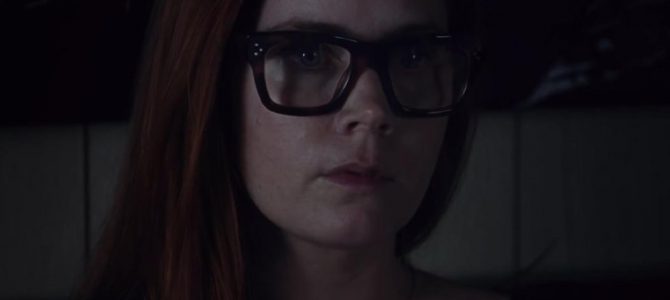
“Nocturnal Animals” is a perniciously difficult film to review. As soon as the lights came up and the credits slowly rolled onscreen, I immediately wanted to watch it again. There is so much going on in this movie, and so few thematic guideposts, that it almost demands repeat viewings.
Written and directed by Tom Ford—yes, that Tom Ford, the maestro of high-class menswear—“Nocturnal Animals” opens by introducing Susan Morrow (Amy Adams), the curator of a modern art gallery and the wife of a wealthy financier. The gallery, however, is falling on hard times, and her relationship with her husband grows chillier by the day.
Then, out of nowhere, a mysterious package turns up at her door. Sent by her ex-husband Edward Sheffield (Jake Gyllenhaal), the package contains the first draft of a brutally dark Western noir novel—starring a protagonist with a suspicious resemblance to Sheffield himself.
As the novel opens, Tony Hastings (Gyllenhaal) is traveling across West Texas late at night with his wife and daughter. A fender bender in the wilderness soon gives rise to nightmarish horror, sending Hastings on a burning quest for frontier justice. Or, at least, that’s what it seems like.
The Film Beautifully Blends Plotlines and Palettes
Purely as a piece of cinema, “Nocturnal Animals” is quite watchable, deploying intense imagery in the service of nerve-shredding moments. In terms of its cast, the film is on solid footing: Gyllenhaal’s performance is the real standout here, building on the range he displayed in movies like “Prisoners” and “Nightcrawler.” Adams is great as always, but she has very little to do onscreen other than read Sheffield’s novel and bleakly ponder existence.
Structurally, the movie blends three thematically intertwined narratives—one past, one present, and one fictionalized—in a style reminiscent of Darren Aronofsky’s “The Fountain.” Ford seamlessly cuts between flashbacks to Susan and Sheffield’s marriage, Susan’s present-day life amid the galas of upper-crust Los Angeles, and the grim storyline of Sheffield’s novel.
For the most part, these threads mesh beautifully: Ford has crafted a richly textured film with superb production values, gorgeous music, and haunting cinematography. Imagine the styles of Terrence Malick and David Fincher overlapping, and you’ll have a good idea of what “Nocturnal Animals” feels like.
The film’s two core plotlines—the stories of Susan and Hastings—could not be more different visually. The former is spare, minimalistic, and highbrow, like an Apple store or contemporary law firm. The latter is gritty and dingy, with a saturated color palette, evoking comparisons to the Coen Brothers’ “No Country for Old Men.” Yet instead of clashing, they complement each other. Whether intentionally or not, Ford has successfully generated visual motifs for both neoliberal and populist America, reflecting the two radically distinct cultures that coexist in contemporary life.
What Is ‘Nocturnal Animals’ Really About?
Unfortunately, thematically speaking, “Nocturnal Animals” is on less steady ground. In the most straightforward reading, this is a story about the concepts of strength and weakness as they relate to masculine identity.
Sheffield is clearly tormented by what he views as a lack of fortitude in himself—a vice that poisoned his prior relationship with Susan and that, in turn, hamstrings his fictional avatar. Over and over, we see Sheffield, or his literary counterpart, fail to display the resilience and resolve necessary to take ownership of his circumstances—a pattern of failure that gives rise to an achingly painful, and deeply memorable, present-day conclusion.
“Nocturnal Animals,” however, wants to have more to say than just “people are troubled and will endlessly castigate themselves.” This is a movie that positively seethes with baroque intensity, and it ought to be analyzed on a deeper level.
A better, and subtler, reading of “Nocturnal Animals” centers on the relationship between individuals and art, and the quest for meaning that underlies any act of creation: is art a means of exorcising our demons, or immortalizing them?
‘Nocturnal Animals’ and Our Relationship to Art
The movie opens with a garish image: a morbidly obese dancer performing a series of slow-motion routines. When the camera zooms out, the audience realizes that these routines are projected on individual screens, forming one of the art exhibitions curated by Susan. In an early, almost throwaway conversation, Susan laments the perceived meaninglessness of her life’s work and the vapidity of what passes for sophisticated art.
The soulless sterility of Susan’s gallery clashes violently with the passionate intensity animating Sheffield’s novel. Though uneven, and suffused with tortured energy that never finds a proper outlet, Sheffield’s novel derives its emotional power from foundational human experiences—real love, real pain, and real inner torment.
This theme can even be read as an ironic critique of “Nocturnal Animals” itself: this is clearly a film directed at art-house audiences, lacking many of the tropes and easy resolutions common to Hollywood blockbusters. But, like Susan’s art, it also lacks the willingness to let its themes bite deeply by tapping into universal human experiences—the joys and sorrows that themselves give rise to popular tropes, like a hero defending his family or a good man refusing to succumb to rage.
It bears mention that this is in no way a movie that will appeal to all audiences. Like other neo-noir films with a similar aesthetic and tone—Aronofsky’s “Black Swan” or Nicolas Winding Refn’s “The Neon Demon”—“Nocturnal Animals” is a film that is experienced, never fully enjoyed. Even though I am a great fan of this genre, I still can’t say exactly whether I genuinely liked this movie or not. But when viewed as a meditation on the relationship between humanity and art, and as a memorable vision of the distance that separates one America from another, “Nocturnal Animals” succeeds with flying colors.









